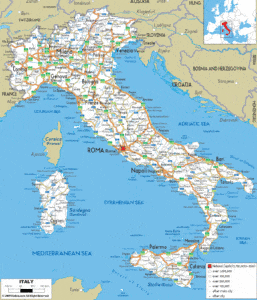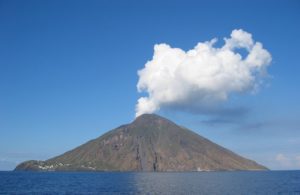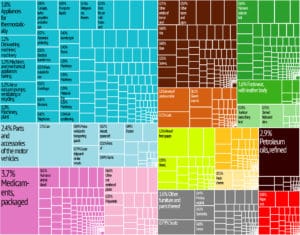Over 35% of the Italian territory is mountainous. The Apennine Mountains form the peninsula’s backbone, and the Alps form most of its northern boundary, where Italy’s highest point is located on Mont Blanc (Monte Bianco) (4,810 m or 15,780 ft). Other worldwide-known mountains in Italy include the Matterhorn (Monte Cervino), Monte Rosa, Gran Paradiso in the West Alps, and Bernina, Stelvio and Dolomites along the eastern side.

The Po, Italy’s longest river (652 kilometres or 405 miles), flows from the Alps on the western border with France and crosses the Padan plain on its way to the Adriatic Sea. The Po Valley is the largest plain in Italy, with 46,000 km2 (18,000 sq mi), and it represents over 70% of the total plain area in the country.
Many elements of the Italian territory are of volcanic origin. Most of the small islands and archipelagos in the south, like Capraia, Ponza, Ischia, Eolie, Ustica and Pantelleria are volcanic islands. There are also active volcanoes: Mount Etna in Sicily (the largest active volcano in Europe), Vulcano, Stromboli, and Vesuvius (the only active volcano on mainland Europe).

The five largest lakes are, in order of diminishing size: Garda (367.94 km2 or 142 sq mi), Maggiore (212.51 km2 or 82 sq mi, whose minor northern part is Switzerland), Como (145.9 km2 or 56 sq mi), Trasimeno (124.29 km2 or 48 sq mi) and Bolsena (113.55 km2 or 44 sq mi).
Although the country includes the Italian peninsula, adjacent islands, and most of the southern Alpine basin, some of Italy’s territory extends beyond the Alpine basin and some islands are located outside the Eurasian continental shelf. These territories are the comuni of: Livigno, Sexten, Innichen, Toblach (in part), Chiusaforte, Tarvisio, Graun im Vinschgau (in part), which are all part of the Danube‘s drainage basin, while the Val di Lei constitutes part of the Rhine’s basin and the islands of Lampedusa and Lampione are on the African continental shelf.
Economy:
Italy has a major advanced capitalist mixed economy, ranking as the third-largest in the Eurozone and the eighth-largest in the world. A founding member of the G7, the Eurozone and the OECD, it is regarded as one of the world’s most industrialized nations and a leading country in world trade and exports. It is a highly developed country, with the world’s 8th highest quality of life in 2005 and the 26th Human Development Index. The country is well known for its creative and innovative business, a large and competitive agricultural sector (with the world’s largest wine production), and for its influential and high-quality automobile, machinery, food, design and fashion industry.

Italy is the world’s sixth largest manufacturing country, characterized by a smaller number of global multinational corporations than other economies of comparable size and many dynamic small and medium-sized enterprises, notoriously clustered in several industrial districts, which are the backbone of the Italian industry. This has produced a manufacturing sector often focused on the export of niche market and luxury products, that if on one side is less capable to compete on the quantity, on the other side is more capable of facing the competition from China and other emerging Asian economies based on lower labor costs, with higher quality products. Italy was the world’s 7th largest exporter in 2016. Its closest trade ties are with the other countries of the European Union, with whom it conducts about 59% of its total trade. Its largest EU trade partners, in order of market share, are Germany (12.9%), France (11.4%), and Spain (7.4%).
